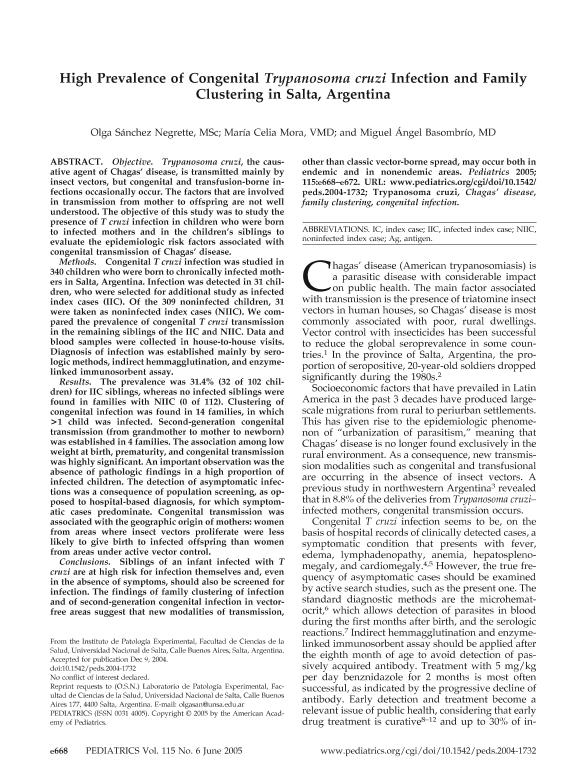Artículo
High Prevalence of Congenital Trypanosoma cruzi Infection and Family Clustering in Salta, Argentina
Fecha de publicación:
06/06/2005
Editorial:
American Academy of Pediatrics
Revista:
Pediatrics
ISSN:
0031-4005
Idioma:
Inglés
Tipo de recurso:
Artículo publicado
Clasificación temática:
Resumen
Objective.Trypanosoma cruzi, the causative agent of Chagas’ disease, is transmitted mainly by insect vectors, but congenital and transfusion-borne infections occasionally occur. The factors that are involved in transmission from mother to offspring are not well understood. The objective of this study was to study the presence of T cruzi infection in children who were born to infected mothers and in the children's siblings to evaluate the epidemiologic risk factors associated with congenital transmission of Chagas' disease.
Methods. Congenital T cruzi infection was studied in 340 children who were born to chronically infected mothers in Salta, Argentina. Infection was detected in 31 children, who were selected for additional study as infected index cases (IIC). Of the 309 noninfected children, 31 were taken as noninfected index cases (NIIC). We compared the prevalence of congenital T cruzi transmission in the remaining siblings of the IIC and NIIC. Data and blood samples were collected in house-to-house visits. Diagnosis of infection was established mainly by serologic methods, indirect hemmagglutination, and enzyme-linked immunosorbent assay.
Results. The prevalence was 31.4% (32 of 102 children) for IIC siblings, whereas no infected siblings were found in families with NIIC (0 of 112). Clustering of congenital infection was found in 14 families, in which >1 child was infected. Second-generation congenital transmission (from grandmother to mother to newborn) was established in 4 families. The association among low weight at birth, prematurity, and congenital transmission was highly significant. An important observation was the absence of pathologic findings in a high proportion of infected children. The detection of asymptomatic infections was a consequence of population screening, as opposed to hospital-based diagnosis, for which symptomatic cases predominate. Congenital transmission was associated with the geographic origin of mothers: women from areas where insect vectors proliferate were less likely to give birth to infected offspring than women from areas under active vector control.
Conclusions. Siblings of an infant infected with T cruzi are at high risk for infection themselves and, even in the absence of symptoms, should also be screened for infection. The findings of family clustering of infection and of second-generation congenital infection in vector-free areas suggest that new modalities of transmission, other than classic vector-borne spread, may occur both in endemic and in nonendemic areas.
Palabras clave:
Trypanosoma Cruzi
,
Chagas Disease
,
Family Clustering
,
Congenital Infection
Archivos asociados
Licencia
Identificadores
Colecciones
Articulos(IPE)
Articulos de INST.DE PATOLOGIA EXPERIMENTAL
Articulos de INST.DE PATOLOGIA EXPERIMENTAL
Citación
Sánchez Negrette, Olga; Mora, Maria Celia; Basombrío, Miguel Ángel Manuel; High Prevalence of Congenital Trypanosoma cruzi Infection and Family Clustering in Salta, Argentina; American Academy of Pediatrics; Pediatrics; 115; 6; 6-6-2005; 668-672
Compartir
Altmétricas




